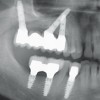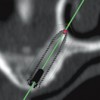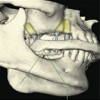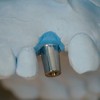It can be argued that osseointegration has had a greater impact on the practice of dentistry than any technology introduced during the last 50 years. For the first time replacement of dentition with dental implants has become predictable. The purpose of this program of instruction is to briefly review the biologic processes that lead to the anchorage of titanium implants in bone. The material covered includes a discussion of the biologic factors leading to successful osseointegration and the prerequisites for achieving it.
Implant Dentistry – Biologic Basis Osseointegrated Implants— Course Transcript
- 1. 1. Biologic Basis for Osseointegration John Beumer III DDS, MSDivision of Advanced Prosthodontics, Biomaterials and Hospital Dentistry, UCLA This program of instruction is protected by copyright ©. No portion of this program of instruction may be reproduced, recorded or transferred by any means electronic, digital, photographic, mechanical etc., or by any information storage or retrieval system, without prior permission.
- 2. Implant Osseointegration SurfaceDefinition – Direct structural Boneand functional contact betweenordered, living bone and thesurface of a load carryingimplant.! Why is osseointegration such an importantdevelopment in implant dentistry?! Predictability. For the first time replacementof dentition with implants was very predictable.
- 3. Osseointegration A radically new concept in implant dentistryWhy? What is so different about these implants?! Upon placement, bone is deposited onthe surface of the implant firmly anchoringit in the surrounding bone.! There is no fibrous connective tissueinterface between the surface of theimplant and the adjacent bone.! As a result epithelial migration along thisinterface is prevented
- 4. Osseointegration * Discovered by P. I. Branemark in the 1960’s while he was conducting a series of animal experiments concerned with wound healing in bone.In these experimentshe used an opticalchamber made oftitanium. When heattempted to removethe chamber from itsbone site he noticedthat the bone adhered Boneto the titanium chamber * * Chamber *with great tenacity. *Courtesy P.I. Branemark
- 5. Osseointegration – Early Work of Branemark* He immediately recognized the importance of this phenomenon and during the next several years he experimented with various sizes and shapes including a design with features of both subperiosteal and endoseal implants. Over 50 designs were tested. He and his colleagues finally settled on a simple* screw shape with a hex on the top.* *Courtesy P.I. Branemark
- 6. Problems with previous implant systemsv Mostof the previous implant systems were made of chrome-cobalt or similar alloys which were subject to corrosion.v Corrosion,with release of metallic ions into the surrounding tissue, precipitated both acute and chronic inflammatory responses resulting in encapsulation of the implant with fibrous connective tissue.v Epithelial migration, development of extended peri-implant pockets, and chronic infections led to exposure of the implant framework and its eventual removal.
- 7. Subperiosteal Implants of Chrome Cobaltv With the previous systems Implant Suspensory ligament ofimmediately following placement Strut collagen fibersthe metal struts of the implantsbecame enveloped by fibrousconnective tissue.v Upon occlusal loading the Bonecollagen fibers became orientedto resist these forces and formeda suspensory ligament (arrows). * Implant strut *Courtesy R. JamesNote the ligamentous like attachment to bone (circle).However, immediately after surgical placement the oralepithelium begins to migrate along the interface betweenthe implant struts and the fibrous connective capsule.
- 8. Subperiosteal Implants – Method of Support v Subperiosteal implants evolved to take advantage of this phenomenon v The design was improved by the addition of implant struts parallel to the occlusal plane. v These designs provided more support for the occlusal forces and prevented the implant from being impacted into the bone.
- 9. Subperiosteal Implants of Chrome Cobalt Implant strutsThe epithelial migration led to formation of extendedperi-implant pockets which in turn developed chronicinfections. These infections led to the exposure ofthe implant struts and eventually loss of the implant.
- 10. Subperiosteal Implants of Chrome CobaltThese infections wereparticularly destructive ofbone in the maxillae.In these two patients substantial portions of the hard palate werelost secondary to infections caused by subperiosteal implants.
- 11. Uniqueness of Titanium v Most metals are not suitable as biomaterials because of the aforementioned corrosion and continuous release of metal ions into adjacent tissues. v The presence of these ions cause acute and chronic inflammatory responses which eventually result in fibrous encapsulation of the offending material and epithelial migration then follows if the material extends through the skin or mucosa.Titanium however is resistant to corrosion and spontaneouslyforms a coating of titanium dioxide, which is stable,biologically inert and promotes the deposition of a mineralizedbone matrix on its surface. In addition, it is strong, and easilymachined into useful shapes.
- 12. Uniqueness of Titanium Properties of titanium – Summaryv Resistant to corrosionv Spontaneously forms a coating of titaniumdioxide, which is stable, biologically inertand with the proper surface topographypromotes the deposition of a mineralizedbone matrix on its surface.v It is strong, and easily machined intouseful shapes.
- 13. Osseointegration – Biologic Processesv Blood clot formation, plasma proteins are attracted to the area accompanied by the release of cytokines and growth factors (BMP’s, VEGF etc)v Angiogenesisv Osteoprogenitor cell migration to the bone osteotomy site and the surface of the implantv Cell differentiationv Deposition of bone on the surface of the implant surface and the osteotomy site (Contact and distance osteogenesis) Completion of these processes on takes about from 8 weeks to 4 months depending upon the implant surface.
- 14. Osseointegration – Clot Formationv Bloodclot formation, plasmaprotein adsorptionaccompanied by the release ofcytokines and growth factors(BMP’s, VEGF etc) v The magnitude of plasma protein adsorption (fibrinogen, fibronectin, albumina and others) is increased and accelerated by the microrough surfaces compared to the machined surfacesv Fibrin scaffold is createdv Angiogenesis begins
- 15. Osseointegration –Clot Formation Plateletsv De-granulate and release mitogenic, chemo- attractive and vasoactive factorsv Attracts stem cells onto the fibrin scaffold Cytokines and growth factors
- 16. Osseointegration – Clot Formation Fibrin Scaffold Develops v Serves as a means of transit forImplant stem cells as they migrate to thesurface surface of the implant and the osteotomy site v Plays a role in wound contraction through the action of fibroblasts v Micro-rough surfaces appear to better retain and maintain the fibrin scaffold structure better than machined surfaces l Clot retraction especially seen with machined surfaces
- 17. Migration and Differentiation of Mesenchymal Stem Cells Functioning osteoblastv Stem cells migrate to the implant surface and into the osteotomy site via the fibrin networkv The micro-rough facilitates clot retention and cell migration
- 18. Osseointegration – Osseous Healing Osteotomy SiteDistance osteogenesis • Ingrowth of bone from the lateral wall of the ostetomy site Implant SurfaceContact osteogenesis • Implant surface acts as a site for colonization and differentiation of osteoprogenitor cells followed by the deposition of bone
- 19. Osseointegration – Biologic Processes Oseous Healing v Micro-rough surfaces facilitate and promote contact osteogenesis v The new surface topographies increase the rate of contact osteogenesis on the implant surface
- 20. Osseointegration – Remodelingv Process where Osteoid preexisting woven, Mineral Osteoclasts damaged and necrotic bone is removed and TGF-β, OP-1 replaced with new bone through the actions of a Source: Lynch, Genco and Marx. basic multicellular unit Tissue Engineering 1999 (BMU). v Necessary to maintain bone anchorage during functional loading during the life of the implant
- 21. The Bone-Titanium Implant Interface * This interfacial zone of boneTitanium layer Implant matrix proteins is surface similar to the material found in the “cement lines”Titanium dioxide between layers oflayer * Bone bone.Surface film of complex phosphates oftitanium and calciumNoncollagenous bone matrix proteins(osteopontin, osteocalcin and bonesialoprotein, ie cement line)Mineralized bone matrix *Courtesy of M. Weinlander
- 22. Titanium – Epithelial Interface What is the mechanism of Sulcus Implant Surface attachment? Epithelium v Hemi-desmosomal – basal lamina system * Circumferential collagen fibers Bone Hemi-desmosomes*Courtesy P. I. Branemark
- 23. Titanium – Epithelial Interface Sulcus Epithelium Implant SurfaceBiologic widthphenomenon 3 – 4 mml Similar to that found in natural dentitionl Generally 3-4mml Significant impact on bone levels and Circumferential therefore esthetics in collagen fibers the anterior region Bone *
- 24. Prerequisites for Achieving Osseointegrationv Uncontaminated implant surfacesv Creation of congruent, non- traumatized implant sitesv Primary implant stabilityv Norelative movement of the implant during the healing phase
- 25. Uncontaminated Implant Surfaces Bioreactivity of the implant surface is impaired if it becomes contaminated with organic molecules ! The surface charge is changed from positive to negative ! The surface becomes less wetable
- 26. Uncontaminated Implant SurfacesLight-treated acid-etched surface! *p<0.0001 Original! Light! N=4 100 * 80 * 60 40 20 0 Day 14! Day 28! Bone–implant contact!
- 27. Prerequisites for Achieving Osseointegration Creation of congruent, non-traumatized implant sitesCareful preparation of the implant site is critical to obtaining astate of osseointegration between implant fixture and bone.During surgical preparation of the site, bone temperatures above47 degrees centigrade create necrotic bone and lead to impairedhealing and increased likelihood of a connective tissue interfaceforming between the implant fixture and the bone.
- 28. Prerequisites for Achieving Osseointegration Congruent implant sites v The smaller the gap between the osteotomy site and the implant surface the better v For osseointegration to occur the gaps that exist between the bone and the surface of the implant are initially filled with blood clot and if the gap is too large the clot may become detached v The bone adjacent to the site may also be damaged (over heated) during surgery. v In an ideal situation, these gaps are small (less than 1 mm), the amount of damaged bone created during surgical preparation of the bone site is minimal, and the implant remains immobilized during the period of repair. v Under these circumstances the implant becomes osseointegrated a very high percentage of the time (95% or greater with the modern implant surfaces).
- 29. Prerequisites for Achieving Osseointegration Congruent, nontraumatized site preparation v In this patient the coronal portion of the bone site was either overheated over- prepared. v The apical portion of the implant is osseointegrated but the upper half of the implant is encapsulated in fibrous connective tissue. v Epithelial migration will likely lead to formation of deep peri-implant pockets, chronic infections and loss of the implant. So-called wide body implants (6mm diameter) have a lower success rate (80% vs 97%) than the traditional 4mm diameter implants probably because it is more difficult to prepare the osteotomy site.
- 30. Prerequisites for Achieving Osseointegration Wall of osteotomy Congruent, site preparation Old bone New bone With the new surfaces the gaps between the implant surface and the osteotomy site can be up to two mm and still fill in with bone if primary immobilization of the implant is achieved and maintained.
- 31. Prerequisites for Achieving Osseointegration Primary implant stability Submerged Implants Micromovement is thought to disturb the tissue and vascular structures necessary for initial bone healing. Davies (1994) suggested that excessive micromotion of the implant during healing prevents the fibrin clot from adhering to the implant surface. Eventually, the healing processes are reprogrammed leading to a connective tissue interface as opposed to a bone implant interface.
- 32. Prerequisites for Achieving Osseointegration Absence of micromotion during the healing period Immediately following placement the bone implant appositional index is approximately 10-15% even in favorable bone sites such as the anterior mandible. If the implant is subjected to occlusal load at this point and mobilized, a fibrous connective tissue encapsulation results. It takes 2-4 months to repair the trauma secondary to preparation of the implant site and develop sufficient bone anchorage to withstand occlusal loads without provoking a resorption remodeling response of the investing bone.
- 33. Prerequisites for Achieving Osseointegration Factors leading to fibrous encapsulation and failure to achieve osseointegration! Overpreparation of the site – gap between the bone and the surface of the implant is too large • Machined surfaces vs micro-rough surfaces! Overheating the site – the necrotic bone produced must be phagocytized before healing and deposition of new bone can occur! Micromotion of the implant during the healing phase • Immediate loading?! Contamination of the implant surface prior to placement
- 34. Progressive OsseointegrationFollowing initial healing (4-6 months)the bone appositional index (amountof bone contact with the surface ofthe implant) continues to increase towhere it approaches almost 90% infavorable sites (such as the anteriormandible when bicortical anchorageis achieved during surgicalplacement). In most bone sites theindex varies from 35-70%. Theindex is highest in the anteriormandible and lowest in the posteriormaxilla
- 35. v Visitffofr.org for hundreds of additional lectures on Complete Dentures, Implant Dentistry, Removable Partial Dentures, Esthetic Dentistry and Maxillofacial Prosthetics.v The lectures are free.v Our objective is to create the best and most comprehensive online programs of instruction in Prosthodontics


 Restoration of Posterior Quadrants and Treatment Planning
Restoration of Posterior Quadrants and Treatment Planning
 Prosthodontic Procedures and Complications
Prosthodontic Procedures and Complications
 Angled Implants
Angled Implants
 Cement Retention vs Screw Retention
Cement Retention vs Screw Retention
